
Table of Contents
What is Hepatitis?
- Hepatitis refers to an inflammatory state of the liver.
- It is usually caused by viral contamination however; there are other potential causes of hepatitis. These contain autoimmune hepatitis and hepatitis that follows as a secondary consequence of medications, drugs, toxins, and alcohol.
- Autoimmune hepatitis is a disease that happens when a human body produces antibodies against the liver tissue.
- There are 5 main hepatitis viruses referred to as Hepatitis A, B, C, D and E.
- Diverse virus is liable for every type of virally transmitted hepatitis.
- These five types of hepatitis are of greatest concern because of the burden of illness, related death, potential for outbreaks and epidemic spread.
Summary of Different Types of Hepatitis:
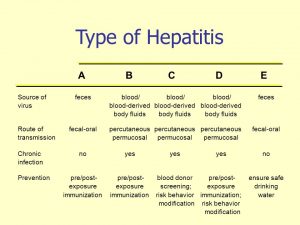
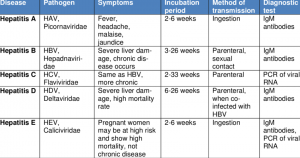
Detail Description of Different types of hepatitis, their causes, symptoms, preventive measures & treatment
1. Hepatitis A

- Hepatitis A is triggered by an infection with the hepatitis A virus (HAV).
- Most of the time, HAV infections are mild. However, sometimes these infections can be severe and life-threatening.
a) Mode of Transmission
- Hepatitis A virus (HAV) is most frequently transmitted through consumption of food or water contaminated by feces of individual suffering from hepatitis A.
- Certain sex practices can also spread HAV.
b) Symptoms
- Flu-like signs (fever, fatigue, body aches)
- Stomach pain (especially in the right upper quadrant)
- Light-colored stool
- Dark urine
- Loss of appetite
- Inexplicable weight loss
c) Preventive Measures
- Avoid alcohol
- Retain a healthy diet
- Drink adequate amount of water
- Washing hands before eating or drinking, and later using the lavatory
- Drink bottled water instead of local water in developing nations, or in nations where there’s a high threat of getting hepatitis A
- Safe and effective vaccines to prevent HAV
- Avoid having unwrapped or raw fruit and vegetables in an area with low cleanliness or hygienic criteria
d) Treatment
- No formal treatment for hepatitis A as it is a short-range viral infection that goes away on its own; treatment is usually centered on decreasing your symptoms.
2. HEPATITIS B
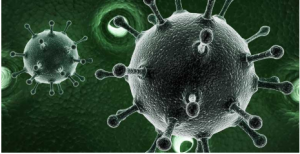
- Hepatitis means inflammation of the liver and causes serious liver disease and liver cancer.
- Hepatitis B is a part of a group of hepatitis viruses.
a) Mode of Transmission
- Hepatitis B Virus (HBV) is transmitted through exposure to infective blood, semen and other bodily fluids.
- Transmission may occur through transfusion of contaminated blood, using contaminated injections and injection drug use.
- It can also transmit from infected mother to child during pregnancy.
- This mode of transmission of HBV also poses threat to health workers for accidental needle stick injuries while caring infected HBV patients.
b) Symptoms of Hepatitis B
- Abdominal pain.
- Dark urine.
- Fever
- Joint pain.
- Loss of appetite.
- Nausea and vomiting.
- Weakness and fatigue.
- Yellowing of your skin and the whites of your eyes (jaundice)
- Chronic HBV infection can lead to liver cancer, liver failure, and cirrhosis.
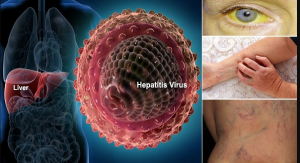
c) Preventive Measures
- Cautious about body piercing and tattooing
- Vaccination (Hepatitis B vaccine) recommended for both newborns and adults.
- No use of drugs.
- Use of latex condom
- Know the HBV status of a sexual partner
- Safe and effective vaccines to prevent HBV.
d) Treatment
- There is no exact treatment for acute hepatitis B, and most people get better within one to two months. Generally, we can cope with the symptoms at home with painkillers if required.
3. HEPATITIS C

- Hepatitis C is a part of a group of hepatitis viruses.
a) Mode of Transmission
- Hepatitis C Virus (HCV) is mainly transmitted through exposure to infected blood.
- Transmission may occur during transfusion of contaminated blood and blood products, contaminated injections and injecting drug use.
- Apart from that, in some cases sexual transmission of virus is also possible but it is less common.
b) Symptoms of Hepatitis C
- The first phase of the disease is called acute hepatitis C and covers the first 6 months after a person is infected. During this phase, most people show no symptoms at all.
- Feeling very tired.
- Sore muscles.
- Joint pain.
- Fever
- Nausea or poor appetite.
- Stomach pain.
- Itchy skin.
- Dark urine.
- Yellow discoloration of the skin and whites of the eyes called jaundice.
c) Preventive Measures
- Use of sterilized equipment for getting body piercing or a tattoo.
- Avoid sharing personal care items with an infected person.
- Follow universal blood precautions and safety
- Avoid injecting illegal drugs
- Use of latex condom and safe sex practices
d) Treatment
- Majority of individuals with hepatitis C do not need treatment. Nevertheless, requires steady check-ups for three months to get if the body is fighting with the virus.
- Individuals who develop a chronic infection, there is a cure, and individuals with chronic infection do not certainly progress liver damage.
- If an individual already gets hepatitis C then it is recommended to have the immunization against hepatitis A and B to protect the liver from extra damage.
- There is no vaccine for HCV.
4. Hepatitis D
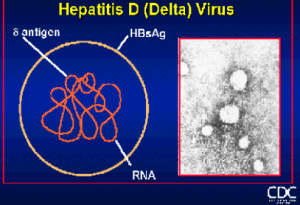
- Hepatitis D, also identified as the hepatitis delta virus, is an infection responsible for liver inflammation.
- This swelling can damage liver function and cause lasting liver problems, containing liver scarring and cancer. The hepatitis D virus (HDV) causes the disorder.
- The symptoms of hepatitis B and hepatitis D are alike, so it can be tough to define which disease is triggering your symptoms.
- Hepatitis D virus (HDV) infection occur only in those who are infected with HBV.
- This dual infection of HBV and HDV can cause more serious consequences.
a) Symptoms
Symptoms of hepatitis B and hepatitis D are alike, so it can be tough to define which disease is triggering your symptoms.
b) Preventive measures
- Get vaccinated. Adults who are at high possibility for infection, such as those who use intravenous drugs, should be immunized.
- Use protection.
- Avoid or stop using recreational pills that can be inserted, such as heroin or cocaine.
- Be alert about tattoos and piercings.
c) Treatments
- There are no recognized treatments for acute or chronic hepatitis D. Not like further forms of hepatitis, existing antiviral medications do not seem to be exact operative in treating HDV. Heavy doses of medication termed interferon for up to 12 months.
5. Hepatitis E
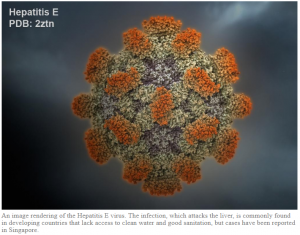
- Hepatitis E is a waterborne disease triggered by the hepatitis E virus (HEV).
- Hepatitis E is mostly found in regions with pitiable hygiene and usually results from ingesting a fecal substance that pollutes the water supply.
- Hepatitis E outbreak is more common in developing countries.
a) Transmission
- It is mostly transmitted through consumption of contaminated water and food.
b) Symptoms
- Dark urine
- Joint pain
- Loss of appetite
- Pain in the abdomen
- Liver enlargement
- Acute liver failure
- Nausea
- Vomiting
c) Preventive measures
- To avoid constricting hepatitis E, be careful about drinking unclean water.
- In developing countries, drink first decontaminated or boiled water.
- Avoid uncooked or unpeeled foods. These include fruit, vegetables, and shellfish, which are usually rinsed in water.
- It is also important to practice good hygiene and wash your hands often.
d) Treatment
- People with severe acute illness and for the pregnant women, management with the medication ribavirin for 21 days has caused in improved liver function in certain minor studies.
- If hepatitis E is doubted and the immune system is not repressed, there is no need for medicines. A clinician may recommend taking rest, drinking plenty of fluids, avoiding alcohol, and practicing good sanitation until the contamination lessens.
- Pregnant women, people with suppressed immune systems, or people with acute liver failure will possibly be hospitalized and supervised.
References and For More Information:
https://www.who.int/features/qa/76/en/
https://www.avert.org/sex-stis/sexually-transmitted-infections/hepatitis-b
https://www.avert.org/sex-stis/sexually-transmitted-infections/hepatitis-c
https://www.healthline.com/health/hepatitis-a#prevention
https://www.healthline.com/health/hepatitis#types
https://www.healthline.com/health/delta-agent-hepatitis-d
https://www.healthline.com/health/hepatitis-e
https://web.stanford.edu/group/virus/delta/2005/